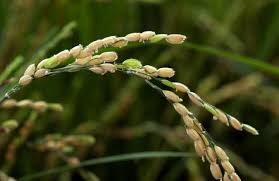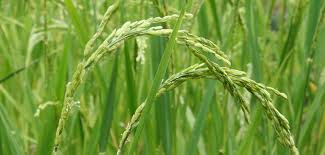Rice panicles, also known as rice inflorescences, are the flowering structures of the rice plant (Oryza sativa). They play a crucial role in the reproduction of rice by bearing the individual flowers that eventually develop into rice grains. The panicle is composed of various structural components, each with a specific function in the reproductive process.
The central axis of the rice panicle, also known as the rachis, supports all the other components. It extends upward from the node where it originates on the rice plant. These are the branches that arise from the main stem (rachis). They bear the spikelets, which are the individual flowering structures of the rice plant. Primary branches can vary in length and number, depending on the rice variety.
The rice panicle undergoes a series of developmental stages, from the emergence of the main stem to the formation of spikelets, florets, and ultimately, rice grains. Proper care and management of rice panicles are essential for achieving healthy grain production in rice cultivation.
The Economic Importance and Uses of Rice Panicles

Rice panicles are an essential component of the rice plant and hold significant economic importance due to their various uses and contributions to human consumption, agriculture, and industry. Rice panicles refer to the flowering and seed-bearing structures of the rice plant.
Here are some of the economic importance and uses of rice panicles:
1. Food Source and Nutrition: The primary economic importance of rice panicles lies in their role as a major staple food for a large portion of the global population. Rice grains are harvested from the panicles and provide essential nutrients like carbohydrates, proteins, and some vitamins and minerals.
2. Human Consumption: Rice panicles are processed to obtain rice grains, which are consumed directly by humans. They serve as a key source of calories and energy, particularly in regions where rice is a dietary staple.
In many Asian countries, rice is a central part of meals, such as rice bowls, sushi, and rice-based desserts.
3. Culinary Uses: Rice is used in a wide range of culinary dishes, from main courses to side dishes and desserts. Different rice varieties have distinct cooking characteristics, making them suitable for various dishes.
4. Export and Trade: Many countries are major exporters of rice, contributing to their economies. Rice panicles are harvested, processed, and milled before being packaged and exported to international markets.
Read Also: Rice Stems: Economic Importance, Uses and By-Products
5. Domestic Agriculture: Rice panicles serve as the reproductive structures of the rice plant, contributing to the growth of new rice plants. Farmers collect rice seeds from panicles to cultivate new crops, ensuring a steady supply of rice for consumption.
6. Cultural and Traditional Uses: Rice is deeply embedded in the cultural practices and traditions of many societies. Rice panicles are used in religious rituals, festivals, and ceremonies, adding to their cultural significance.
7. Animal Feed: Rice straw, the leftover plant material after rice grains are harvested, can be used as animal feed. It provides roughage and some nutritional value for livestock. Rice straw can be used to feed cattle, sheep, and other livestock.
8. Biofuel Production: Rice straw and husks can be used in the production of biofuels, such as biogas and bioethanol, contributing to renewable energy sources. Rice straw can be converted into biogas through anaerobic digestion, which can then be used for cooking or electricity generation.
9. Industrial Uses: Rice bran oil, a byproduct of rice milling, is used in various industrial applications, including food processing, cosmetics, and pharmaceuticals. Rice bran oil is used in the production of soap, edible oil, and even as a nutritional supplement.
10. Rice Byproducts and Derivatives: Beyond the rice grains themselves, rice panicles yield various byproducts and derivatives that have economic value. These include rice bran, rice husks, and broken rice.
11. Fertilizer and Soil Amendment: Rice straw, after harvesting the grains, can be returned to the fields as organic matter, serving as a natural fertilizer and improving soil structure. Incorporating rice straw into the soil can enhance its water-holding capacity and nutrient content, contributing to sustainable agriculture.
12. Research and Breeding: Rice panicles are crucial for plant breeding programs aimed at developing improved rice varieties with higher yields, disease resistance, and other desirable traits.
13. Medicinal and Herbal Uses: Rice and rice-related products have been used in traditional medicine for various purposes, and different parts of the rice plant, including panicles, may have potential health benefits. In some cultures, rice water extracted from washing rice is used for skin care and as a remedy for digestive issues.
14. Crafts and Artwork: In certain cultures, rice panicles are used for crafting purposes, such as creating traditional decorations, artwork, or even as material for weaving. In parts of Southeast Asia, rice straw is used to create intricate and decorative crafts.
15. Carbon Sequestration: Rice fields play a role in carbon sequestration, which has environmental implications. Rice panicles and the associated plant material contribute to the overall carbon cycle. Proper water and land management practices in rice cultivation can enhance carbon sequestration in rice fields.
16. Tourism and Cultural Promotion: In regions where rice cultivation is a traditional practice, rice fields and panicles can become tourist attractions, contributing to local economies through cultural and agrotourism.
17. Seed Industry: The production of rice seeds from panicles is a key component of the seed industry, ensuring a continuous supply of high-quality seeds for rice cultivation. Seed companies produce and distribute certified rice seeds to farmers, supporting agricultural productivity.
The Products and By-products That Can Be Derived From Rice Panicles

Rice panicles are the flowering and seed-bearing structures of the rice plant (Oryza sativa). They contain rice grains, which are the primary product of rice cultivation. However, there are several by-products and secondary products that can be derived from rice panicles during processing.
Here’s a list of these products, along with explanations, examples, and processes:
1. Rice Grains (Primary Product): Rice grains are the main product derived from rice panicles. They are the edible part of the plant and a staple food for many cultures around the world. Example: White rice, brown rice, basmati rice, jasmine rice, etc.
After harvesting, rice panicles undergo milling to remove the husk, bran, and germ layers, resulting in different types of rice grains.
2. Rice Bran Oil (By-product): Rice bran oil is extracted from the outer bran layer of rice grains. It is a rich source of nutrients and has various culinary and industrial applications. Cooking oil, soap production, cosmetics, etc.
The bran is separated from rice grains during milling, and then it undergoes an extraction process to obtain rice bran oil.
3. Rice Bran (By-product): Rice bran is the outer layer of the rice grain that is removed during the milling process. It is a valuable by-product with many potential uses. Rice bran is separated from rice grains during milling and can be further processed for various applications.
4. Rice Husk (By-product): Rice husk is the protective outer layer of the rice grain. It has several applications due to its lightweight and insulating properties. Fuel, building materials, bedding material, etc. Rice husks are separated from rice grains during milling and can be used as a raw material for different purposes.
5. Rice Straw (By-product): Rice straw is the stem and leaves of the rice plant left over after harvesting. It can be used for various purposes, especially in agriculture and industry. Animal feed, bedding material, thatching, compost, etc. Rice straw is collected after harvesting rice panicles and can be processed for different applications.
6. Rice Water (By-product): Rice water is the starchy water obtained during rice washing or cooking. It contains nutrients and has been used for various health and beauty purposes. Rice water is collected during the washing or cooking of rice and can be used directly or further processed for specific applications.
Read Also: 10 Medicinal Health Benefits of Tetraneuris torreyana (Torrey’s four-nerve daisy)
7. Rice Flour (Secondary Product): Rice flour is finely ground rice grains and is used in various culinary and industrial applications. Baking, cooking, gluten-free products, thickening agent, etc. Rice grains are ground into a fine powder to produce rice flour.
8. Rice Starch (Secondary Product): Rice starch is extracted from rice grains and is used in various food and non-food applications. Food processing, pharmaceuticals, textile industry, etc. Rice grains are processed to extract starch, which can then be used in different industries.
These products and by-products demonstrate the versatility of rice panicles and their potential contributions to various industries and daily life.
In conclusion, rice panicles and the various components of the rice plant have multifaceted economic importance and a wide range of uses that extend beyond their role as a staple food source. From food production and agriculture to industry, culture, and environmental contributions, rice panicles play a vital role in supporting economies and livelihoods across the world.
Read Also: 31 Healing Powers of Bitterleaf (Vernonia Amygdalina)
